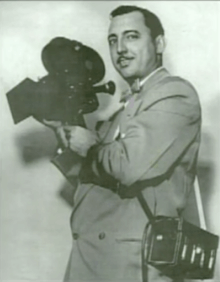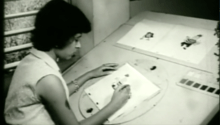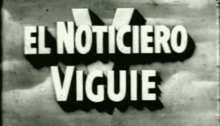Juan Emilio Viguié Jr.
Juan Emilio Viguié Jr[1] is a Puerto Rican producer-entrepreneur credited with the development of the film industry as an enterprise in Puerto Rico in the early 1950s. During a career that spanned over five decades, Viguié Jr. produced, directed and photographed countless short films, documentaries, and television commercials for the local and mainland US markets.[2]
Juan Emilio Viguié, Jr. | |
|---|---|
 | |
| Born | Juan Emilio Viguié Rodríguez April 4, 1923 Ponce, Puerto Rico |
| Died | 2004 (aged 80–81) San Juan, Puerto Rico |
| Occupation | Film and documentary producer |
| Nationality | Puerto Rican |
| Spouse | Dolores Fernández |
| Children | Juan Emilio “John” Viguié III, Maria Ivonne "Maruja" Viguié |
Early years
Born April 4, 1923 in the Island's southern city of Ponce, he is the eldest son of Puerto Rican film pioneer Juan Emilio Viguié Cajas,[3] who among many other accomplishments in the film industry, also produced, directed and photographed “Romance Tropical” (1934), the Island's first full-length feature film with sound and the second Spanish language film with sound in the world.
Since childhood, Juan Jr. worked closely with his father and learned early on about cinematography and other aspects of the film industry. He also helped his father produce Viguié Telenews, a newsreel shown in theaters across Puerto Rico.[4][5]
Career
After receiving his honorable discharge from the US Army in 1946, Juan establishes Puerto Rico Industrial Photography in San Juan, and dedicates to advertising and commercial photography.
In 1950, during the Nationalist revolt known as the Jayuya Uprising, Juan borrows a 35mm Arriflex camera and rushes to the town of Jayuya, PR, where he films the revolt and the brutal counterattack by the armed forces. He exhibits the footage across the Island's theaters, and soon decides to establish his own newsreel which he names "El Noticiero Viguié".[6]
The success of his newsreel not only rekindles his love for film, but also makes it possible for him to establish the first movie studio on the Island; Viguié Film Productions, Inc., complete with soundproof rooms, 16mm and 35mm film developing laboratories, sound recording facilities, a woodshop for set construction and editing rooms. Always envisioning being at the forefront of the industry with the latest technology of the time, he also integrates the first animation studio in Puerto Rico and pioneers the use of animation techniques in his newsreels and TV advertising.[7]
With hardly any experienced crew available at the time, for many years Viguié Film Productions, Inc. becomes a training ground and incubator of new talent in the emerging field of cinematography on the island. With modern efficient facilities and an experienced crew, "El Noticiero Viguié" turns into a weekly newsreel and is also shown in New York and other major cities with Hispanic communities across the US. Though his original intent on building the studio was to produce feature films, when television arrives to Puerto Rico in 1954 the increased workload requires he places it on hold. Viguié Films starts to air the first news program that incorporates film footage and sound interviews in its newsfeed.
Viguié Film Productions also starts producing the vast majority of the television commercials for the emerging advertising industry in the island. Juan also lands contracts with the major Madison Ave. ad agencies to produce, direct and photograph numerous commercials in English geared to the US mainland markets. His company soon opens offices in New York City to better attend his stateside clients.[7]
In 1963, Juan incorporates a second production facility together with Roberto and Marino Guastella, two brothers who had recently immigrated from Cuba. The new company is named Viguié-Guastella, and has its own separate facilities and personnel.[5][10]

As the companies continue to flourish, in 1971 Telemundo, a local media conglomerate founded by Angel Ramos and owner of WKAQ radio, WKAQ Channel 2 Television, and El Mundo newspaper, makes an offer to acquire the organization. Juan sells Viguié Film Productions and Viguié-Guastella to Telemundo, who then changes the name to Creative Films. As part of the contractual transaction, Juan signs a ten-year non-competition agreement preventing him from establishing a new film studio that could compete with Creative Films. When his son John returns from New York in 1975 where he studied cinematography at NYU, Juan starts a new enterprise; Viguié Multimedia. The new company produces Epcot-like audio-visual presentations, consisting of projecting great quantities of simultaneous still images onto very large screens, synchronized to a captivating soundtrack with narrative. The images were beamed to the screens through a vast array of Kodak 35mm slide projectors, sometimes up to more than 30, all controlled and programmed with the analog computers available at the time. Multimedia presentations proved to be an innovative and effective way of storytelling, and became extremely popular at a worldwide level.[3] Viguié Multimedia becomes the first and largest multimedia company on the Island, and soon moves into a new 10,000 sq.ft. facility in the heart of Hato Rey, complete with photographic studios, film developing laboratory, two small theaters, sound studio, and camera equipment to produce special visual effects.
With the advent of personal computers in the early 1990s, the company transitions to digital technology and starts producing interactive CD-ROMs and DVD's, web pages, computer graphics, and incorporates digital photography and compressed videos in the presentations.
Later Years
In 1996 Juan E. Viguié Jr. retires, and leaves an indelible mark in history as being an instrumental element in the development of the film industry in Puerto Rico.
In 2000, his son, John E. Viguié, redirects the company towards film production, and changes the name back to Viguié Films. John went on to produce numerous high-end television commercials, along with two full-length feature films in co-production with Spain; “Agua con Sal” (2005) and “La Mala” (2008).[11]
References
- "Ancestry Files".
- "Un Visionario".
- "Cinemovida".
- "José Antonio Torres Martino: Voz de Varios Registros".
- "Historia del Cine Puertorriqueño".
- "Archivo General de Puerto Rico".
- "Juan Emilio Viguié: Un Visionario".
- "Noticias Viguie".
- "Viguié News Footage".
- "Historia del cine puertorriqueño".
- "Cinemovida Biografías".
